Heian Period |
|
|
Whereas during the Asuka period and the Nara period the Japanese modeled their architecture on Chinese and Korean architecture, the Heian period marked the re-emergence of Japanís own unique architectural style. Following the collapse of the mighty and influential Tíang dynasty in China and the move of the capital from Nara to Nagaoka and finally to Kyoto, the distinct Japanese style of temple architecture emerged because the Japanese simply lost some of the great respect they previously held towards the culture and wisdom of the Tíang. This style was enhanced by Japanís geographical isolation. Japan is a small and compact island nation perfectly suited for distancing itself from the influences from outside sources. So as foreign influences were cut off, Japan turned to its own ideas behind architecture to create a purely Japanese architecture. While Buddhist architecture flourished during the Nara period, the indigenous Shinto architecture and the domestic architecture of aristocrats and other wealthy people developed simultaneously. It was not until the fall of the Tíang dynasty that Japanese Buddhist architecture responded to the architectural trends developing within Japan by adapting the architecture of the villas and courtyards for use in Buddhist temple architecture. Aristocratic architecture had been developing independent of religious architecture to suit the needs of the Imperial family and the very wealthy. The villas and detached palaces they built on the outskirts of Kyoto influenced the return of the temples from the mountains back to the cities. The temple layouts of this era began to center around landscaped gardens and ponds, a practice previously found in villas, but adapted for use in temples. The evolution of Buddhism to the new Jodo Buddhism appealed to aristocrats because of the belief that praying towards an image of Buddha was the most essential component towards salvation. This enticed the wealthy to build their own prayer halls on their villa or manor and from there evolved many of the temples of this period; a private prayer hall and manor could easily be converted into a monastery and would also virtually guarantee the nobleís passage towards salvation and rebirth into the Western Paradise.
|
